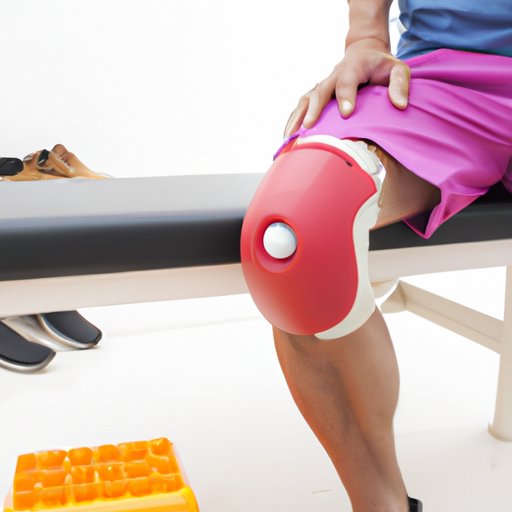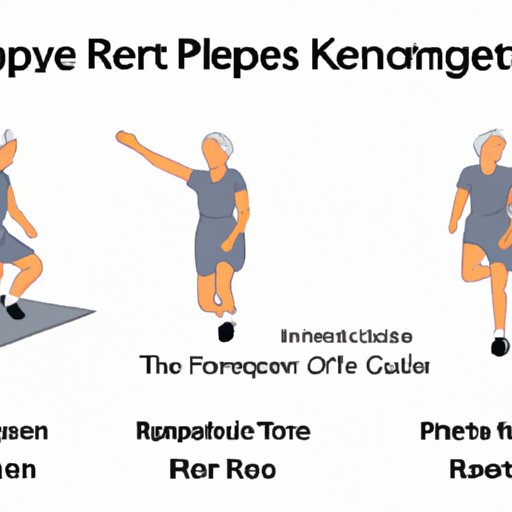
Introduction
Knee replacement surgery is a common procedure used to alleviate pain and restore function in a damaged knee joint. The procedure involves the removal of damaged or worn surfaces and the replacement of these surfaces using artificial implants. However, the success of the surgery does not end with the operation. Physical therapy is essential for full recovery.
The purpose of this article is to provide information on the length of physical therapy after knee replacement surgery. It is intended for anyone who has undergone knee replacement surgery and is interested in knowing how long it takes to regain full function of their knee joint.
The Road to Recovery: Understanding the Duration of Physical Therapy After Knee Replacement Surgery
Physical therapy is a crucial part of the recovery process after knee replacement surgery. It helps to improve mobility and strength in the knee joint while reducing pain and swelling. However, the duration of physical therapy varies from patient to patient and depends largely on the individual’s health and the severity of their condition before surgery.
Importance of Physical Therapy After Surgery
The main goal of physical therapy after knee replacement surgery is to promote healing and restore function to the affected joint. Physical therapy also helps to reduce the risk of complications such as stiffness, blood clots, and infection. A well-designed physical therapy program can help the patient to return to their normal activities as soon as possible.
Factors That Affect the Duration of Physical Therapy
The duration of physical therapy after knee replacement surgery depends on several factors. These factors include:
- The patient’s age
- The severity of the knee damage before surgery
- The presence of other medical conditions
- The patient’s commitment to the physical therapy program
Generally, patients will need to attend physical therapy sessions for several months after surgery. However, the exact length of time will vary depending on each patient’s unique situation.
General Timeline for Physical Therapy after Knee Replacement
In general, the duration of physical therapy after knee replacement surgery follows a timeline. Here is a general timeline for physical therapy after knee replacement:
- Weeks 1-2: Passive Range of Motion (PROM) exercises to help move the leg gently and reduce swelling. Weight-bearing is not allowed, and mobility aids are essential.
- Weeks 2-4: Strengthening and light range of motion exercises using therapy bands and weights. Patients are still not allowed to put weight on the affected leg.
- Weeks 4-6: Stabilization and balance exercises. Once approved, weight-bearing will start, and patients may start to use crutches or a walker to help them walk around.
- Weeks 6-12: Increasing range of motion and strength training with weight machines, cardiovascular exercises, and functional training. Walking without a mobility aid becomes a focus.
- Months 3-6: Return to normal activities and exercises, building strength and stamina.
Getting Back on Your Feet: A Guide to the Length of Physical Therapy for Knee Replacement Patients
Physical therapy after knee replacement surgery can be challenging, and it requires a lot of time and effort. However, it is vital to follow the prescribed therapy timeline for optimal results.
Importance of Following the Prescribed Physical Therapy Timeline
The prescribed physical therapy timeline has been formulated by experts to aid in recovery effectively. By following this timeline, patients can rest assured that their knee joint is adequately healing and they will soon regain full function. Skipping therapy sessions or discontinuing physical therapy can lead to complications such as stiffness or weakness in the affected joint.
Explanation of Each Stage of Physical Therapy Post-Surgery
The different stages of physical therapy after knee replacement surgery have already been outlined above. Each stage has a particular goal, and patients should work closely with their physical therapist to monitor their progress.
How to Work with Your Physical Therapist to Track Progress
Tracking progress is essential when undergoing physical therapy. Patients should work closely with their physical therapist to identify specific goals and track their progress towards achieving these goals. A physical therapist helps monitor progress and makes adjustments to the therapy plan as required.
Patience and Persistence: Navigating the Timeline of Physical Therapy After Knee Replacement
The recovery process after knee replacement can be long and challenging, but it’s important to stay motivated. Here are some tips for navigating the timeline of physical therapy:
How to Stay Motivated During a Long Recovery Process
Staying motivated during a long recovery process can be difficult, but it’s essential for optimal recovery. Patients can stay motivated by setting achievable goals and tracking progress regularly. Additionally, having the support of family and friends is incredibly helpful.
Coping with Setbacks and Adjusting Your Expectations
The recovery process after knee replacement surgery is not always straightforward. Patients may experience setbacks along the way. It’s essential to be realistic and adjust expectations accordingly when setbacks occur.
Tips for Managing Pain and Discomfort During Physical Therapy
After knee replacement surgery, patients may experience pain and discomfort during physical therapy. It’s essential to communicate with the physical therapist about any difficulties or discomforts experienced. Pain medication may be helpful, and patients should practice relaxation techniques to help reduce stress and anxiety.
The Importance of Post-Op Physical Therapy: How Long Can You Expect It to Last After a Knee Replacement?
The benefits of physical therapy after knee replacement surgery are significant. Physical therapy helps improve mobility, strength, and flexibility of the affected joint. Additionally, rehabilitation can reduce the risk of complications such as blood clots, stiffness, and infection.
Discussion of the Long-Term Effects of Physical Therapy Adherence
Adherence to the prescribed physical therapy timeline has long-term benefits. Patients who continue to exercise and strengthen their knee joint after rehabilitation have a better chance of the knee replacement lasting for more extended periods.
Strategies for Maintaining the Progress Achieved Through Physical Therapy
Patients who complete physical therapy after knee replacement surgery should continue to exercise and strengthen their knee joint. Swimming, walking, and other low-impact activities are ideal for exercising the knee joint without stressing it. Regular visits to the physical therapist can help monitor progress and identify issues early on.

From Range Of Motion to Strengthening Exercises: An Overview of Physical Therapy After Knee Replacement Surgery
Explanation of the Goals of Each Stage of Physical Therapy
The goals of each stage of physical therapy after knee replacement surgery have already been outlined above. The goals evolve from gentle passive range of motion to strengthening the knee joint and the surrounding muscles.
Overview of Specific Exercises and Techniques Used in Physical Therapy
The exercises and techniques used in physical therapy after knee replacement surgery depend on the patients’ individual requirements and physical ability. Common exercises include exercises to work on knee extension and flexion, quadriceps and hamstring strengthening exercises, and low-impact cardio exercises.
The Benefits of Range of Motion and Strengthening Exercises After Knee Replacement
Range of motion and strengthening exercises after knee replacement surgery help improve mobility and strength in the affected leg. It also helps to reduce pain and discomfort while reducing the risk of complications such as stiffness and blood clots.
Supporting Your Rehabilitation: Guidelines for the Duration of Physical Therapy Following Knee Replacement
Understanding the Resources and Support Systems Available During Physical Therapy
Physical therapy after knee replacement surgery can be challenging, but several resources and support systems can help patients. Patients can rely on their physical therapist, family, and friends for support. Additionally, support groups and forums can also be helpful.
The Role of Caregivers and Family in Supporting the Rehabilitation Process
Caregivers and family members can play a vital role in supporting the rehabilitation process. They can help manage appointments, provide emotional support, and assist with daily activities. An engaged and supportive caregiver or family member can be instrumental in ensuring a successful recovery.
Tips for Integrating Physical Therapy into Daily Life
Physical therapy after knee replacement surgery takes time and effort, but with proper planning, it can be integrated into daily life. Patients should speak with their physical therapist about how to modify their daily activities to support physical therapy. Additionally, setting aside specific times of day for physical therapy can help keep patients on track.
The Long Game: Preparing for the Duration of Physical Therapy After Knee Replacement Surgery
Discussing the Benefits of Preparing Mentally and Physically for a Long Recovery Process
Preparing mentally and physically for a long recovery process is crucial in optimizing recovery after knee replacement surgery. Patients should discuss with their physical therapist what they can do to prepare before surgery.
Pre-Surgery Exercises That Can Help with Post-Surgery Physical Therapy
Patients can perform several exercises before knee replacement surgery that can help with post-surgery physical therapy. These exercises will focus on strengthening muscles in the affected leg. Consult with the physician before starting this exercise routine.
Advice for Planning and Managing Daily Activities During Physical Therapy
Planning and managing daily activities during physical therapy will be critical in ensuring a smooth recovery. Patients should work with their physical therapist and caregivers to schedule appointments and plan regular exercise times.
Conclusion
Physical therapy is critical after knee replacement surgery, and the duration varies depending on patients’ individual situations. Patients must follow the prescribed physical therapy timeline for optimal results. It’s essential to stay motivated, focused, and maintain an open line of communication with your physical therapist. With proper care and management, patients will see significant improvements and return to their regular activities.
Final tips and advice for navigating the physical therapy timeline
Remember to be patient, stay focused, and diligently follow the prescribed physical therapy timeline for optimal results. Work with your physical therapist to track your progress and adjust goals and expectations accordingly. With hard work and determination, you will be back to your regular activities in no time.





